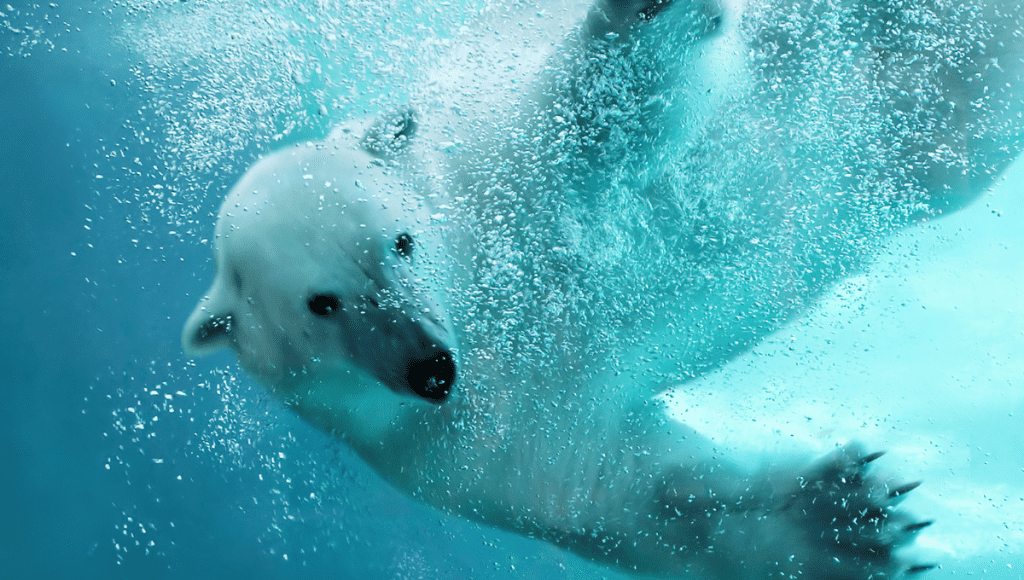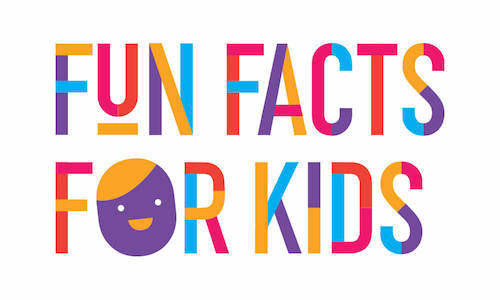Do you want to find cool facts about polar bears? Then you’re in just the right place! This one in our series of animal guides focuses on those cuddly creatures that inhabit some of the coldest, most icy places on earth. Brrr!!!
Whether it’s for a school assignment you’ve been given or you have a special interest in these mammals, discover all the most interesting facts about polar bears right here.
Feel like cuddling up with your own polar bear – or giving one to your younger brother or sister? Find irresistibly cute polar bear soft toys here.
Cool facts about polar bears
Polar bears are actually classed as marine mammals by science and nature experts. This is because they spend so much time on the ice of the Arctic Ocean. They’re the only type of bear in the marine mammal category.
These bears live on frozen parts of the Arctic Ocean. They may live in Alaska (US), Canada, Greenland, Norway and Russia. Polar bears hunt on the ice, and live in snow dens when they have young cubs to raise.
Polar bear numbers worldwide are around 26,000. These have been divided by naturalists into 19 subpopulations. There isn’t enough evidence to know how nine of these sub-units are doing. The remaining 10 comprise five stable subpopulations, with four declining and only one increasing.
Sadly, this is because polar bears are seriously at risk. They have to devote so much of their time to finding food, and the threats posed by mankind doesn’t make life any easier for these magnificent creatures. Climate change, pesticides and the gas and oil industries all cause problems for these beautiful bears.
Education is one of the best weapons we can use against destruction of a species. Learning information about polar bears and spreading the word can help. So on a lighter note, let’s turn to some fun polar bear facts to keep things interesting.
10 fun facts about polar bears
To show how fun these huge creatures can be to study, here are the top 10 facts about polar bears that might just make your jaw drop!
- Polar bears are the biggest type of bear species worldwide. Male polar bears are twice as big as females. One can be as heavy as about ten human men, and they can be up to three metres long. Polar bears are also the planet’s largest carnivores.
- The biggest polar bear ever literally weighed a ton. It was around 1,002 kilos, and a ton is a thousand kilos. The bear was about 3.65 metres tall. It was discovered in Alaska in 1960, and remains the biggest polar bear in the world to date.
- Polar bear fur is transparent, not white. It’s the light it reflects that makes it look white to the human eye. This helps with camouflage.
- Polar bears have black skin. Underneath that translucent fur is another surprise. Who’d have thought that beneath that cosy fur coat a polar bear’s skin would actually be as black as ebony? (Ebony is a black wood that was traditionally polished for making black piano keys.) This has a useful purpose, as it helps them to absorb as much sunlight as possible in freezing cold climates, keeping them warmer.
- Polar bears spend around half of their lives hunting for food. And only about 2% of their hunts are successful. No wonder they need to hunt for so long – and it’s lucky that they can smell their prey even when it may be kilometres away! Can you imagine spending that amount of time trying to get something to eat? Even professional chefs spend less time in the kitchen.
- Polar bears prefer seals to other types of food. Bearded and ringed seals make for a polar bear’s favourite meal, but at a push they’ll also eat birds and their eggs, small mammals or plants. They can also willingly strip a carcass clean.
- Polar bears can swim at speed of up to 10 kilometres per hour (or around 6 miles). That’s pretty fast for such a big and heavy creature! Their front paws act like paddles, propelling them through the ocean.
- Polar bear footprints can tell scientists all about that individual animal. And even, sometimes, about the seal they devoured for dinner. This is due to a pioneering DNA technique developed by SPYGEN (a DNA company) and the WWF.
- Polar bears can be adopted by humans. No, we’re not talking about taking one into your house and treating it like a member of the family! Via the WWF, people living all over the planet can pay a monthly sum to help sponsor a polar bear.
- Polar and grizzly bears have together created the pizzly bear. The most obvious of the pizzly bear facts is the fact that these came from grizzly and polar bears.
Why not embellish your project with the cutest polar bear stickers around?

Pizzly bear facts [or grolar bear facts]
Here are a few more fun facts about pizzly bears – or grolar bear facts! Why read 5 facts about polar bears, when you could impress your friends with your knowledge of a more unusual type?
- A pizzly bear can also be called a grolar bear, grizzlar, zebra bear, or nanulak.
- Grolar or pizzle bears have occurred both in the wild and in captivity.
- The existence of the first pizzly known to man was discovered in the Canadian Arctic in 2006.
- Normally, a pizzly bear will have a polar bear for a mother, so it grows up as a marine mammal rather than a land-based bear.
- Scientists reckon that the global pizzly bear population is on the increase due to climate change. Melting ice drives polar bears further south in search of food, where they meet and mate with grizzly bears.
Polar bear cubs facts
For the cuteness factor, be sure to check out these polar bear cubs facts! Aww.
- After polar bear mums become pregnant, they must gain around 200 kilos or more in weight to ensure a healthy birth.
- On average, female polar bears give birth only once every three years, and most litters consist of two cubs. If females can access more food, though, they may have cubs every other year.
- Polar bear cubs are born in November, December or January, in snow dens where they can be kept warm. Most of these are on land, and have a ventilation hole in the top.
- Polar bear cubs are born with their eyes shut, and they’re also very small and helpless. They also look like they have no fur, as it’s very fine at this point.
- Baby polar bears are only about as big as a guinea pig. They weigh about half a kilo and are around 30 centimetres long at birth.
- Polar bear milk is 33% fat. For comparison, cow’s milk is 3 to 4 percent fat, and human milk around 4.5% fat.
- By the time they’re two months old, polar bear cubs are walking, have started growing teeth and boast a lovely thick coat of fur.
- A cub doesn’t see the light of day and explore the outside world properly until it’s about four or five months old. This is when the happy family finally emerges from their snow den.
- Polar bear cubs stay with their mums for about two years. She’ll teach them how to survive in the very harsh Arctic conditions.
- Once the cubs are about two-and-a-half years old on average, the mother polar bear can breed again. At the point she might chase away the cubs, and be followed around by a male polar bear instead.
Learn more about these creatures by buying polar bear books for all ages.

polar bear endangered facts
Polar bear extinction facts are sadly – well, a fact of life for polar bears. Here are five key reasons why polar bears are at risk.
- Climate change. The world is warming up. This destroys the icy habitat of the polar bear, and also melts the snow they could use to create snow dens. It also leaves them with less time to find food.
- The oil industry. Man’s never ending search for oil spells disaster for polar bears. Oil exploration can destroy the habitat of the polar bear. As for oil spills – these can cause poisoning and even make their fur less effective in insulating them.
- The gas industry. Likewise, the hunt for natural gas also threatens the Arctic environment of the polar bear.
- Pesticides. One of the lesser known polar bear diet facts is that pesticides can enter these animals via the prey they feed on.
- Grolar or pizzly bears. Most females have cubs only once every two or three years. Each time a littler of pizzly bear cubs is born, that means the mother will have no polar bear cubs for two to three years. Thus reducing their numbers even further.
Fun polar bear facts for kids
From polar bear habitat facts and a few weird facts about polar bears to polar bear fur facts and
five facts about polar bears created with grizzlies, we hope you’ve found this collection of polar bear trivia fascinating.
If you enjoyed this polar bear fact file, don’t forget to take a look at some of our other animal facts for kids. Check out the list below for inspo!
Animal facts for kids
- Giant Panda Bear Facts for Kids
- Ant Facts for Kids
- Crocodile Facts for Kids
- Dolphin Facts for Kids
- Echidna Facts for Kids
- Bee Facts for Kids
- Australia’s Deadliest Animals Facts for Kids
- Cheetah Facts for Kids
- Endangered Animals Facts for Kids
- Kangaroo Facts for Kids
- Possum Facts for Kids
- Quokka Facts for Kids
- Koala Facts for Kids
- Dog Facts for Kids
- Cat Facts for Kids
- Butterflies Facts for Kids
- Dingo Facts for Kids
- Turtle Facts for Kids
- Penguin Facts for Kids
- Whale Facts for Kids
- Wolf Facts for Kids
- Dinosaur Facts for Kids
- Sustainability Facts for Kids
- Recycling Facts for Kids

